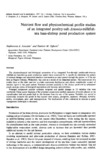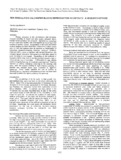Food consumption of seaperch, Lates calcarifer, in captivity.
- Global styles
- MLA
- Vancouver
- Elsevier - Harvard
- APA
- Help
View/
Date
1989Author
Page views
1,730ASFA keyword
AGROVOC keyword
Taxonomic term
Metadata
Show full item record
Share
Abstract
In the Philppines, feeds and constitutes some 70% of the total capital cost in aquacultural, which illustrates the central ipmortance of such inputs and at the same time justifies a major research effort to study the field of nutrition, feeds, and feeding. Given a nutritionally adecquate food, it is necessary to examine whether environmental condition (e.g., water temperature, oxygen , etc.) allow fish to efficiently use the food for growth to ensure a profitable yield. If yioeld is as central to aquaculture as growth is to fish, then the improvement of fish yield in aquaculture should benefit from the fundamental understanding of environmental control of fish growth. In tropical aquaculture where high temperature are the outstanding characteristics, it is worth consideriing whether such temperatures favor efficient fish production. Since temperature increases the rate o metabolic processess in fish, the energetic cost of this elevated metabolic activity may be considered in competition with growth for a share of the energy derived from the food (Brett, 1979). These interacting factors of food (intake and ration) and temperature and their effects on fish growth should be thoroughly studied if an economicaly vaible management is desired.
The present research project focussed on research (Lates calcarofer) aquaculture by using the bio-energetic concept following the models of weel studied species such as perch, Perca fluviatilis (Solomon & Brafield, 1972); sockeye salmon, Oncorhynchus nerka (Brett, 1979); brown trout, salmo trutta (Elliott, 1972; 1975a; 1975b; 1976; 1982), and the African catfish, clarias gariepinus (Hogendoorn, 1983; Machiels & Henken, 1986). This, being a long term goal connat be attained before basic variables will have been studied. The immediate aims of this research project era, therefore, (1) examination of feeding rates and food consumption of the seaperch in relation to body size and temperature, and (2) determination of growth rate in relation to temperature and ration size.
This study will be conducted over a 3-years period. Firstly preliminary trials on feeding rates and food consumption by individual seaperch will be carried out to determine minimumand maximum rations. Subsequently experiments studying the relation between temperature, ration (starvation, maximum, minimum) and growth will be conducted. Variables and parameters to be investigated durig the experiment will concentrate on body size, body composition, composition of growth increment,tempereture and metabolism (oxygen consumption).
Type
Conference paperCollections
- Conference Proceedings [299]
Related items
Showing items related by title, author, creator and subject.
-
Culture of grouper, sea bass and red snapper
Toledo, Joebert D. (University of the Philippines Aquaculture Society, Inc., 2001)Marine fish production has increased dramatically in the past ten years and majority of the cultured species were produced in Asia in 1992. Increase in production was accompanied with concerns on increasing outbreak of ... -
Nutrient flow and physicochemical profile studies of an integrated poultry-salt-Artemia-milkfish-sea bass-shrimp pond production system
Jumalon, Nepheronia A.; Ogburn, Damian M. (Wetteren, Belgium: Universal Press, 1987)The physicochemical and biological parameters of an integrated flow-through poultry-salt-Artemia-milkfish-sea bass-shrimp pond production system were monitored for 6 months to determine the pattern of nutrient changes and ... -
Sea bass (Lates calcarifer Bloch) reproduction in captivity: a research update
Recent advaces in the spontaneous and hormoneinduced breeding of caged sea bass (Lates calcarifer bloch, Family Centropomidae) are reviewed. Spontaneous spawnings follow a semilunar rhythm, with most spawings accurring in ...






